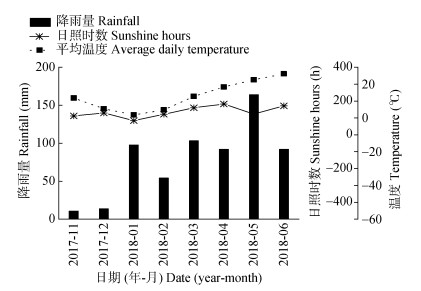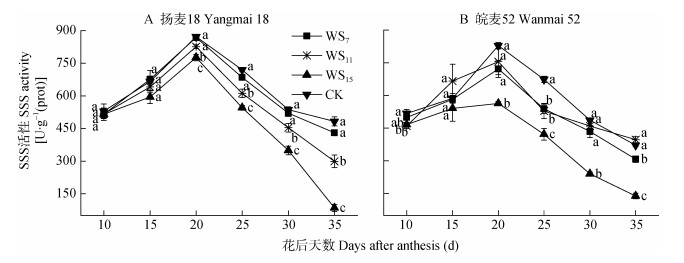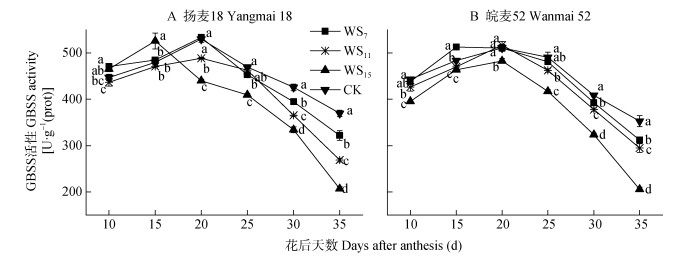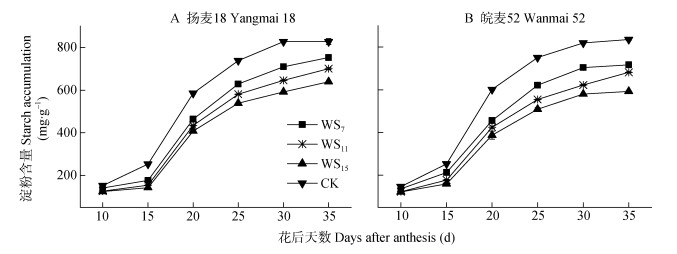长江中下游麦区是中国小麦(Tritium aestivum L.)的主产区之一, 受季风影响, 该地区在小麦产量形成期多发持续性降水[1], 传统的水稻(Oryza sativa L.)-小麦轮作制度又使得土壤质地黏重, 排水性较差[2], 加之小麦在开花期对渍水胁迫较为敏感[3], 因此这个时期阴雨寡照是该地区小麦产量和品质主要限制因素之一[4]。
淀粉是小麦籽粒干物质的主要组成部分, 在小麦成熟时淀粉占籽粒干重的70%[5], 小麦的产量和加工品质很大程度上取决于淀粉的含量[6]。而淀粉在合成过程中要受到多种酶的调控作用[7-8], 其中腺苷二磷酸葡萄糖焦磷酸化酶(AGPase)、可溶性淀粉合成酶(SSS)和结合态淀粉合成酶(GBSS)对淀粉合成和代谢起着关键性的作用[9-10]。AGPase为调节淀粉合成的关键酶[11], SSS与GBSS则分别催化支链淀粉和直链淀粉的合成[12]。有研究认为, 渍水胁迫导致籽粒中AGPase、SSS和GBSS的活性降低, 且灌浆期籽粒中蔗糖代谢和淀粉积累也受到了一定影响[13-14]。同时, 渍水还会使得小麦叶片叶绿素含量下降[15], 影响小麦籽粒干物质的积累[16]。光是小麦光合作用的能量来源[17], 小麦开花后籽粒物质积累主要来源于光合产物[18]。光照强度与小麦产量形成有重要的相关性[19], 是影响小麦光合生产、生长发育和产量的重要因素[20]。阴雨天光照强度降低及光照时间缩短, 会影响小麦旗叶中碳水化合物的合成和转运[21], 对小麦生长发育产生不利影响[22], 降低小麦籽粒干物质积累并最终影响产量[23]。
渍水或遮阴单一胁迫对小麦籽粒淀粉合成、干物质的积累和转运及产量的影响已有较多研究[2, 18, 20], 但关于渍水和遮阴复合胁迫对小麦籽粒淀粉合成及产量影响研究较少。由于渍水遮阴时长对小麦花后干物质积累和产量形成影响较大[16], 因此本试验选用长江中下游地区主栽小麦品种‘扬麦18’(受渍迟钝型)和‘皖麦52’(受渍敏感型), 在小麦开花后人工模拟渍水遮阴胁迫, 分析花后阴雨寡照对小麦籽粒淀粉合成相关酶活性、淀粉积累和干物质积累及产量构成的影响, 为探索缓解长江中下游麦区花后连阴雨造成小麦减产的栽培技术措施提供理论依据。
1 材料与方法 1.1 供试品种根据课题组前期预备试验结果, 选用安徽省江淮地区的主栽小麦品种‘扬麦18’(江苏省里下河地区农业科学院选育)和‘皖麦52’(安徽省宿州市种子公司选育)作为试验材料。其中‘扬麦18’的耐渍能力较强, 而‘皖麦52’对渍涝胁迫较为敏感。
1.2 试验设计试验于2017年11月——2018年6月在安徽农业大学校内试验基地农翠园进行。试验地处中纬度地带, 属亚热带季风性湿润气候, 年平均气温15.7 ℃, 多年平均降水量995.3 mm, 多集中在5——6月, 年日照时间2 100 h。试验期间合肥地区部分气象数据如图 1所示。

|
图 1 试验期间试验区的降雨量、日照时数和平均温度 Fig. 1 Average daily temperature, rainfall and sunshine hours in the study area during the experiment |
采用盆栽+池栽结合的试验方法, 盆栽用钵为直径30 cm, 高30 cm的塑料盆。前茬为水稻, 大田取土粉碎后装入盆内。土壤pH 7.15, 含有机质15.79 g·kg-1, 全氮0.78 g·kg-1, 碱解氮61.3 mg·kg-1, 有效磷7.2 mg·kg-1, 速效钾123 mg·kg-1, 土壤含水量80%。每盆装土8 kg, 施入纯氮1.05 g、K2O 2.25 g、P2O 51.35 g和有机肥75 g, 待小麦拔节后每盆再追施纯氮1.05 g。播种时间为2017年11月11日, 每个品种种植120盆, 相同试验处理埋于同一试验池中, 水泥池长4 m, 宽4 m, 深1 m。盆子上沿与地面平齐, 待三叶期齐苗后间苗, 每盆留生长一致的麦苗8株。田间管理按高产栽培要求进行。
小麦开花后进行渍水遮阴处理, 遮阴和渍水同步进行。渍水处理需保持水层高出盆钵土面1~2 cm。用50%透光率的遮阴网遮阴, 为了保证遮阴网内通风良好, 需使其下沿距地面0.5 m。在小麦开花后连续渍水遮阴7 d、11 d和15 d分别记为WS7、WS11和WS15, 以正常生长的小麦为对照CK, 每个处理重复3次。
在小麦开花后, 标记同一天开花的小穗, 花后10 d开始, 每5 d从各处理中随机选取大小发育一致的麦穗8~10个, 取样分别用于籽粒淀粉合成相关酶、淀粉和干物质积累的测定。待小麦成熟后收获, 测定未取样盆栽中小麦的产量及产量构成因素。
1.3 测定项目与方法 1.3.1 淀粉代谢相关酶活性取10个籽粒称重, 研磨成粉, 加5 mL 100 mmol·L-1 Tricine-NaOH提取液[pH=8.0, 含有10 mmol·L-1 MgCl2, 2 mmol·L-1 EDTA, 50 mmol·L-1 2-Mercaptoethanol, 12% (v/v)Glycerol, 5%(w/v)PVP-40]于研钵中磨成匀浆, 温度保持在0 ℃。在10 000 r·min-1离心10 min, 收集上清液作为粗酶液用于籽粒的AGPase、SSS和GBSS活性测定。
AGPase活性测定参照程方民等[24]介绍的方法。取20 μL酶粗液与110 μL反应液于30 ℃下反应20 min后, 置于沸水中30 s终止反应, 10 000 r·min-1离心10 min, 取上清液100 μL, 加入5.2 μL比色液5.76 mmol·L-1 NADP、0.08 U P-gucomutase、0.07 U G6P-dehydrogenase, 在30 ℃下反应10 min后, 测定340 nm处OD值。SSS和GBSS活性测定参照Nakamura等[25]介绍的方法。
1.3.2 籽粒淀粉含量测定方法采用蒽酮比色法[26]测定。根据Logistic方程W=K/(1+elnA-Bt)拟合籽粒淀粉积累量(W)随开花后天数(t)的变化规律[27](式中A、B为参数, K为生长终值量)。根据该方程及其一级和二级导数, 推导出:
籽粒淀粉积累速率方程(W′):
| $ W^{\prime}=K B \mathrm{e}^{\ln A-B t} /\left(1+\mathrm{e}^{\ln A-B t}\right)^{2} $ | (1) |
籽粒淀粉积累活跃生长期(D, 完成淀粉积累总量90%所需时间):
| $ D=-[\ln (1 / 9)-\ln A] / B $ | (2) |
籽粒淀粉达到最大积累速率的时间(Tmax):
| $ T_{\max }=\ln A / B $ | (3) |
籽粒淀粉平均积累速率(Rmean):
| $ R_{\text {mean }}=-K /[\ln (1 / 9)-\ln A] / B $ | (4) |
籽粒淀粉最大积累速率(Rmax):
| $ R_{\max }=K B / 4 $ | (5) |
每个处理取小麦穗10~15个, 剥出籽粒, 在105 ℃下杀青15 min, 80 ℃烘至恒重, 称重并换算成千粒重。根据Logistic方程y=a/(1+elnb-kt)拟合千粒重(y)随开花后天数(t)的变化规律[28]。其中千粒重潜力值为a, b和k为参数。根据Logistic方程y=a/(1+elnb-kt)和该方程的一级和二级导数, 推导出:
灌浆高峰期起始时间(t1):
| $ t_{1}=[\ln b-\ln (2+1.732)] / k $ | (6) |
灌浆高峰期的结束时间(t2):
| $ t_{2}=[\ln b+\ln (2+71.732)] / k $ | (7) |
灌浆终期(t3, 千粒重达到99%潜力值的时间):
| $ t_{3}=-(4.59512+\ln b) /(-k) $ | (8) |
其他灌浆参数如下:
| $ T_{1}=t_{1} $ | (9) |
| $ T_{2}=t_{2}-t_{1} $ | (10) |
| $ T_{3}=t_{3}-t_{2} $ | (11) |
| $ T=t_{3} $ | (12) |
| $ V_{\mathrm{t}}=a / t_{3} $ | (13) |
式中: T1、T2和T3分别为籽粒灌浆的渐增期, 快增期和缓增期[29], T和Vt分别为籽粒灌浆的持续天数和籽粒平均灌浆速率。
1.3.4 产量构成因素的测定待小麦成熟后, 每处理分别收获未被取样的10盆小麦, 供测定单株穗数、穗粒数、千粒重并计算单株产量。
1.4 数据处理不同处理之间采用SPSS 22.0软件进行单因素方差分析, Dunca法对各项测定数据进行多重比较, 用Origin 9.0进行图形制作。
2 结果与分析 2.1 花后渍水遮阴对小麦淀粉合成相关酶活性的影响 2.1.1 腺苷二磷酸葡萄糖焦磷酸化酶(AGPase)从图 2中可以看出, 花后渍水遮阴处理后, 2个小麦品种籽粒中AGPase的活性变化均呈单峰曲线, 且都在花后20 d左右达到活性峰值。对照籽粒中的AGPase活性在籽粒灌浆过程中一直高于渍水遮阴处理。WS7、WS11和WS15处理小麦籽粒中AGPase活性在花后10~15 d虽然低于对照, 但差异不显著。WS7和WS11处理籽粒中AGPase活性在灌浆期间差异不显著, WS15处理的AGPase活性最低。对于‘扬麦18’, WS7和WS15处理籽粒中AGPase活性从花后20 d开始与对照差异达显著水平, 而WS11处理在花后35 d才与对照有显著差异。‘扬麦18’籽粒中AGPase活性表现为WS11 > WS7 > WS15, 且WS15处理在花后20 d开始显著低于WS11处理。而‘皖麦52’在花后20 d时WS15处理和花后25 d时WS11处理籽粒中AGPase活性显著低于对照, 其他渍水遮阴处理在灌浆期与对照差异未达显著水平。且‘皖麦52’的WS7处理籽粒中AGPase活性略高于WS11处理, 在花后20 d, WS15处理虽与WS7和WS11处理差异显著, 但之后3个渍水遮阴处理间无显著差异。

|
图 2 花后渍水遮阴对不同小麦品种籽粒腺苷二磷酸葡萄糖焦磷酸化酶(AGPase)活性的影响 Fig. 2 Effects of shading and waterlogging treatments after anthesis on adp-glucose pyrophosphorylase (AGPase) activities in grains of different wheat varieties WS7、WS11和WS15分别表示花后渍水遮阴处理7 d、11 d和15 d; 不同小写字母表示处理间差异显著(P < 0.05)。WS7, WS11 and WS15 represent treatments of shading and waterlogging after anthesis for 7 days, 11 days, and 15 days, respectively. Different lowercase letters indicate significant differences among treatments at 0.05 level. |
从图 3可以看出, 2个品种的小麦籽粒中SSS活性花后呈现先升高后降低的变化, 渍水遮阴处理和对照小麦籽粒中SSS活性均在花后20 d左右达峰值。与对照相比, 渍水遮阴处理均降低了花后小麦籽粒中SSS活性。渍水遮阴处理后, 籽粒中SSS活性在花后10~15 d与对照无显著差异, 但WS15处理SSS活性在小麦开花20 d后与对照差异显著。WS15处理籽粒中SSS活性始终低于WS7和WS11处理, 且在小麦开花20 d后, WS15处理籽粒中SSS活性与WS7和WS11处理差异显著。对于‘扬麦18’, 在花后20 d, WS7处理籽粒中SSS活性与对照差异不显著, WS11处理则与对照有显著差异。且‘扬麦18’的WS7处理的SSS活性在花后20 d后显著高于WS11处理。而‘皖麦52’除花后25 d时WS7和WS11处理及花后35 d时WS7处理的SSS活性与对照有显著差异以外, 其他灌浆时期WS7和WS11处理与对照差异均未达显著水平, 且‘皖麦52’的WS7和WS11处理在整个灌浆期间无显著差异。

|
图 3 花后渍水遮阴对不同小麦品种籽粒可溶性淀粉合成酶(SSS)活性的影响 Fig. 3 Effects of shading and waterlogging treatments after anthesis on soluble starch synthase (SSS) activities in grains of different wheat varieties WS7、WS11和WS15分别表示花后渍水遮阴处理7 d、11 d和15 d; 不同小写字母表示处理间差异显著(P < 0.05)。WS7, WS11 and WS15 represent treatments of shading and waterlogging treatments after anthesis for 7 days, 11 days, and 15 days, respectively. Different lowercase letters indicate significant differences among different treatments at 0.05 level. |
从图 4可以看出, 小麦籽粒中GBSS活性在整个灌浆期呈单峰曲线, 但不同渍水遮阴处理GBSS活性峰值出现的时间不同。‘扬麦18’的WS15处理籽粒的GBSS活性在花后15 d最大, 而WS7、WS11处理及对照籽粒的GBSS活性达到峰值的时间为花后20 d; ‘皖麦52’的WS7处理籽粒GBSS活性在花后15 d最大, 其他渍水遮阴处理及对照的籽粒GBSS活性在花后20 d最大。WS7处理的小麦籽粒中GBSS活性在花后10~15 d高于对照, 但在花后20 d籽粒中GBSS活性开始低于对照, 开花20 d之后下降幅度也大于对照, 并于花后30 d开始与对照籽粒中GBSS活性差异显著。WS11处理小麦籽粒活性在花后始终低于对照, 并在小麦开花20 d之后与对照差异显著, WS15处理的小麦籽粒GBSS活性在花后20 d之后与对照相比下降显著。在小麦开花20 d之后, 小麦籽粒的GBSS活性WS7 > WS11 > WS15, 且WS15处理籽粒中GBSS活性显著低于WS7和WS11处理。

|
图 4 花后渍水遮阴对不同小麦品种籽粒结合态淀粉合成酶(GBSS)活性的影响 Fig. 4 Effects of shading and waterlogging treatments after anthesis on granule-bound starch synthase (GBSS) activities in grains of different wheat varieties WS7、WS11和WS15分别表示花后渍水遮阴处理7 d、11 d和15 d; 不同小写字母表示处理间差异显著(P < 0.05)。WS7, WS11, and WS15 represent treatments of shading and waterlogging treatments after anthesis for 7 days, 11 days, and 15 days, respectively. Different lowercase letters indicate significant differences among treatments at 0.05 level. |
由图 5可知, 在小麦籽粒发育的过程中, 淀粉含量在花后15~20 d增加迅速, 并且在花后30 d之后逐渐趋于稳定。在整个灌浆过程中小麦籽粒淀粉含量CK > WS7 > WS11 > WS15, 说明与对照相比, 渍水遮阴处理降低了小麦籽粒中淀粉的积累量, 并且渍水遮阴处理时间越长, 对小麦淀粉积累量影响越大。‘扬麦18’和‘皖麦52’在渍水遮阴处理7 d、11 d、15 d后籽粒淀粉最终积累量分别较对照下降9%、15%、23%和14%、18%、29%。

|
图 5 花后渍水遮阴对不同小麦品种籽粒淀粉含量的影响 Fig. 5 Effects of shading and waterlogging treatments after anthesis on the starch accumulation in grains of different wheat varieties WS7、WS11和WS15分别表示花后渍水遮阴处理7 d、11 d和15 d; 不同小写字母表示处理间差异显著(P < 0.05)。WS7, WS11, and WS15 represent treatments of shading and waterlogging treatments after anthesis for 7 days, 11 days, and 15 days, respectively. Different lowercase letters indicate significant differences among treatments at 0.05 level. |
小麦籽粒淀粉积累进程可用Logistic方程拟合, 各方程的决定系数都达显著水平(表 1)。在本试验中, 与对照相比, 渍水遮阴处理推迟了淀粉最大积累速率出现的时间(Tmax), 并且延长了淀粉积累活跃生长期(D), 但不同渍水遮阴处理间变化幅度较小, 说明渍水遮阴处理时间长短对Tmax和D的影响较小。小麦籽粒淀粉最大积累速率(Rmax)和平均积累速率(Rmean)都表现为CK > WS7 > WS11 > WS15, 说明渍水遮阴处理降低了Rmax和Rmean, 并且渍水遮阴处理时间越长, Rmax和Rmean下降的幅度越大。与对照相比, 渍水遮阴处理7 d、11 d、15 d ‘扬麦18’的Rmax和Rmean分别下降18.3%、22.5%、28.9%和16.5%、22.5%、28.5%; ‘皖麦52’的Rmax和Rmean则分别下降27.1%、34.7%、39.4%和20.1%、27.8%、33.9%。渍水遮阴处理下, ‘皖麦52’的Rmax和Rmean下降的幅度比‘扬麦18’的大。
| 表 1 花后渍水遮阴处理下不同小麦品种籽粒淀粉积累曲线拟合和特征参数 Table 1 Simulation equations of starch accumulation and characteristic parameters of grains of different wheat varieties under shading and waterlogging treatments |
用Logistic方程对籽粒干物质积累动态进行拟合, 拟合方程见表 2。各方程的决定系数都达极显著水平, 说明拟合效果好。渍水遮阴处理后小麦千粒重低于对照, 且处理时间越长, 下降越显著。与对照相比, 渍水遮阴处理延长了籽粒灌浆快增期的时间(T1), 缩短了灌浆缓增期时间(T3), 并降低了小麦的平均灌浆速率(Vt)。渍水遮阴处理的时间长短对小麦籽粒灌浆的各个时期长短并没有明显影响, 但渍水遮阴处理的时间越长, 小麦灌浆的平均速率越小。在渍水遮阴处理的影响下, 与对照相比, ‘扬麦18’增大了T1, 减小了T2、T3和Vt; ‘皖麦52’减小了Vt, 但其他灌浆参数与对照的差异不大。说明在渍水遮阴处理条件下, ‘扬麦18’粒重的降低主要是由于灌浆快增期和缓增期的缩短及平均灌浆速率(Vt)的降低, 而‘皖麦52’籽粒干物质积累的减少主要是由于灌浆平均速率的降低。
| 表 2 花后渍水遮阴处理下不同小麦品种籽粒灌浆曲线拟合和灌浆参数 Table 2 Simulation equations of grain filling process and grain filling characteristic parameters of grains of different wheat varieties under shading and waterlogging treatments |
从表 3可以看出, 与对照相比, 渍水遮阴处理对2个品种小麦的单株穗数影响较小。花后渍水遮阴处理的小麦穗粒数低于对照, WS15处理穗粒数与WS7、WS11处理差异显著, 说明渍水遮阴处理的时间越长, 对小麦穗粒数的影响也就越大。与对照相比, ‘扬麦18’和‘皖麦52’渍水遮阴处理7 d、11 d、15 d的穗粒数分别下降1.8%、6.7%、16.6%和1.9%、6.7%、23.7%。与对照相比, 渍水遮阴处理降低了小麦的千粒重, 其中WS11和WS15处理的小麦千粒重下降显著; 小麦千粒重WS7 > WS11 > WS15, WS7处理的小麦千粒重与WS11处理的没有显著差异, 但WS7处理与WS15处理的千粒重差异显著, 说明渍水遮阴处理的时间越长, 对小麦千粒重的影响越大。渍水遮阴处理7 d、11 d、15 d‘扬麦18’和‘皖麦52’千粒重分别较对照下降9.3%、19.4%、23.6%和11.2%、15.5 %、37.6%。与对照相比, 渍水遮阴处理后小麦产量下降显著; 小麦单株产量WS7 > WS11 > WS15, 且WS15处理与WS7、WS11处理差异显著, 说明处理时间越长对小麦产量影响越大。‘扬麦18’的WS7和WS11处理差异并不显著, ‘皖麦52’的3个不同时长的渍水遮阴处理之间差异显著。与对照相比, ‘扬麦18’和‘皖麦52’在渍水遮阴处理15 d后分别减产47.57%和59.29%。‘皖麦52’在渍水遮阴处理后产量下降幅度大于‘扬麦18’。
| 表 3 花后渍水遮阴对不同小麦品种产量构成的影响 Table 3 Effects of shading and waterlogging treatments after anthesis on yield and yield components of different wheat varieties |
在淀粉合成过程中, AGPase、SSS和GBSS等酶的活性决定着小麦源器官中蔗糖转化为库器官籽粒中淀粉的能力[30]。在本试验中, 小麦籽粒中AGPase、SSS和GBSS活性变化呈单峰曲线, 这与前人研究一致[31]。李亚婷等[32]的研究中小麦籽粒的AGPase和SSS分别在花后20 d和25 d活性最大, 而胡阳阳等[33]的研究中GBSS的活性峰值在花后26 d才出现。在本研究中, 除了‘扬麦18’的WS15处理及‘皖麦52’WS7处理籽粒的GBSS活性在花后15 d达到峰值, 其他处理小麦籽粒的GBSS及AGPase和SSS都于花后20 d左右达到峰值。这说明处理、品种及生长环境等可能改变小麦籽粒中SSS和GBSS活性达峰值的时间, 渍水遮阴处理可能使GBSS活性峰值提前。小麦灌浆前期有些处理的GBSS和SSS活性高于对照, 但渍水遮阴处理下籽粒中AGPase、SSS和GBSS的活性在多数测定时期低于对照, 尤其在灌浆后期, 2个品种的小麦籽粒中SSS和GBSS活性分别于小麦开花25 d和20 d之后大幅度下降。因此, 渍水遮阴处理时间越长, 对小麦籽粒中AGPase、SSS和GBSS活性影响越大, 一般在小麦开花20 d后WS15处理的籽粒中SSS和GBSS活性与处理WS7和WS11的差异显著。
有研究表明, 小麦籽粒中AGPase、SSS和GBSS活性与淀粉积累速率呈显著正相关[29]。用Logistic方程拟合淀粉积累进程表明, 与对照相比, 渍水遮阴处理降低了小麦籽粒淀粉的最大积累速率和平均积累速率, 而对淀粉达到最大积累速率的时间和淀粉积累的生长活跃期影响不大。渍水遮阴处理下小麦籽粒淀粉平均积累速率的降低可能是由于籽粒中淀粉合成相关酶活性的下降引起的, 而小麦平均积累速率的降低是淀粉积累量下降的主要原因。
小麦粒重的大小与籽粒平均灌浆速率大小以及灌浆持续期长短有关[34]。遮阴和渍水导致小麦减产可能是由于影响了籽粒干物质的积累和转运[35-37]。本试验中, 与对照相比, 渍水遮阴处理后籽粒中干物质量都下降, 且随着渍水遮阴处理时长的增加, 对小麦籽粒干物质积累的影响程度也就越大。贺明荣等[38]研究发现, 小麦可能存在某种反应机制来调节弱光对灌浆的影响, 因此遮阴对不同品种千粒重的影响程度不同。不同品种小麦在渍水遮阴处理下对籽粒灌浆的影响程度和方面也不同, ‘皖麦52’籽粒灌浆受到的影响主要来源于灌浆平均速率的降低, 而‘扬麦18’在胁迫处理的条件下不仅降低了平均灌浆速率, 还缩短了灌浆的快增期和缓增期。且渍水遮阴处理的灌浆持续天数与对照差异不大的情况下, ‘皖麦52’的平均灌浆速率的下降幅度高于‘扬麦18’。综合来看, ‘皖麦52’籽粒灌浆受到的影响要比‘扬麦18’大。
刘杨等[39]的研究认为在小麦拔节期, 光照不足可以降低渍水对小麦产生的影响, 而在灌浆期则存在叠加的负面影响。这是由于作物对寡照存在补偿机制[40], 营养生长期可通过增加底部叶片面积等方式来弥补遮阴所造成的影响。小麦抽穗后进入生殖生长期已不能通过增加叶片面积来提高光合效率, 可以通过增加分蘖来增加叶片面积提高光合效率[41]。因此花后渍水遮阴处理对小麦产量存在叠加的负面作用。对小麦产量构成要素而言, 由于抽穗期前已经决定了成穗数, 因此开花后的渍水遮阴处理对小麦穗数影响不大, 对小麦穗粒数有一定影响, 增加了不孕小花数。渍水遮阴处理对产量构成要素中影响最大的是千粒重, ‘皖麦52’产量的降低主要是因为千粒重的下降, 说明渍水遮阴处理严重影响了小麦的籽粒灌浆。因此, 花后渍水遮阴处理导致小麦产量显著下降, 主要是由于千粒重和穗粒数的下降所致。
花后渍水遮阴处理使小麦籽粒中AGPase、SSS和GBSS的活性下降, 影响籽粒淀粉合成, 缩短籽粒灌浆缓增期时间, 降低了淀粉积累和灌浆平均速度, 从而导致小麦籽粒淀粉和干物质积累量减少, 千粒重显著降低, 最终导致产量下降。本试验结果还表明, 不同品种对渍水遮阴处理的反应也不同, 与受渍敏感型品种‘皖麦52’相比, 受渍迟钝型品种‘扬麦18’在渍水遮阴处理的过程中淀粉合成相关酶活性、淀粉含量、干物质的积累和产量的下降幅度较小。因此‘扬麦18’比‘皖麦52’更易抵御渍水遮阴逆境而趋于稳产, 这对在长江中下游平原上培育高产稳产小麦具有一定积极意义。同时, 本研究可对当前阴雨或阴霾等极端天气对小麦产量的影响以及优质小麦抗逆调优栽培提供理论依据。
| [1] |
蔡剑, 姜东. 气候变化对中国冬小麦生产的影响[J]. 农业环境科学学报, 2011, 30(9): 1726-1733. CAI J, JIANG D. The effect of climate change on winter wheat production in China[J]. Journal of Agro-Environment Science, 2011, 30(9): 1726-1733. |
| [2] |
姜东, 陶勤南, 张国平. 渍水对小麦扬麦5号旗叶和根系衰老的影响[J]. 应用生态学报, 2002, 13(11): 1519-1521. JIANG D, TAO Q N, ZHANG G P. Effect of waterlogging on senescence of flag leaf and root of wheat Yangmai 5[J]. Chinese Journal of Applied Ecology, 2002, 13(11): 1519-1521. DOI:10.3321/j.issn:1001-9332.2002.11.039 |
| [3] |
DE SAN CELEDONIO R P, ABELEDO L G, MIRALLES D J. Identifying the critical period for waterlogging on yield and its components in wheat and barley[J]. Plant and Soil, 2014, 378(1/2): 265-277. |
| [4] |
石春林, 金之庆. 基于WCSODS的小麦渍害模型及其在灾害预警上的应用[J]. 应用气象学报, 2003, 14(4): 462-468. SHI C L, JIN Z Q. A WCSODS-based model for simulating wet damage for winter wheat in the middle and lower reaches of the Yangtse River[J]. Journal of Applied Meteorological Science, 2003, 14(4): 462-468. DOI:10.3969/j.issn.1001-7313.2003.04.010 |
| [5] |
李永庚, 于振文, 姜东, 等. 冬小麦旗叶蔗糖和籽粒淀粉合成动态及与其有关的酶活性的研究[J]. 作物学报, 2001, 27(5): 658-664. LI Y G, YU Z W, JIANG D, et al. Studies on the dynamic changes of the synthesis of sucrose in the flag leaf and starch in the grain and related enzymes of high-yielding wheat[J]. Acta Agronomica Sinica, 2001, 27(5): 658-664. DOI:10.3321/j.issn:0496-3490.2001.05.017 |
| [6] |
邓梅, 张雄, 钟小娟, 等. 不同生态环境对四川小麦品种(系)籽粒淀粉含量及理化特性的影响[J]. 麦类作物学报, 2019, 39(1): 64-72. DENG M, ZHANG X, ZHONG X J, et al. Effect of different ecological environments on content and physicochemical properties of starch in wheat varieties (lines) in Sichuan Province[J]. Journal of Triticeae Crops, 2019, 39(1): 64-72. |
| [7] |
RAHMAN S, REGINA A, LI Z Y, et al. Comparison of starch branching enzyme genes reveals evolutionary relationships among isoform. Characterization of a gene for starch-branching enzyme Ⅱa from the wheat D genome donor Aegilops tauschii[J]. Plant Physiology, 2001, 125(3): 1314-1324. DOI:10.1104/pp.125.3.1314 |
| [8] |
谭彩霞, 封超年, 郭文善, 等. 不同小麦品种籽粒淀粉合成酶基因的表达及其与淀粉积累的关系[J]. 麦类作物学报, 2011, 31(6): 1063-1070. TAN C X, FENG C N, GUO W S, et al. Difference in expression of starch synthase gene and starch synthesis in the grains of different wheat cultivars[J]. Journal of Triticeae Crops, 2011, 31(6): 1063-1070. |
| [9] |
KEELING P L, BANISADR R, BARONE L, et al. Effect of temperature on enzymes in the pathway of starch biosynthesis in developing wheat and maize grain[J]. Functional Plant Biology, 1994, 21(6): 807. DOI:10.1071/PP9940807 |
| [10] |
杨毅, 李昱, 康建宏, 等. 花后高温胁迫对春小麦籽粒淀粉合成的影响[J]. 麦类作物学报, 2015, 35(11): 1535-1541. YANG Y, LI Y, KANG J H, et al. Effect of heat stress after anthesis on starch synthesis in spring wheat[J]. Journal of Triticeae Crops, 2015, 35(11): 1535-1541. DOI:10.7606/j.issn.1009-1041.2015.11.11 |
| [11] |
JENNER C F. Starch synthesis in the kernel of wheat under high temperature conditions[J]. Functional Plant Biology, 1994, 21(6): 791. DOI:10.1071/PP9940791 |
| [12] |
王月福, 马东辉, 赵长星, 等. 施氮量和花后土壤含水量对强筋小麦籽粒淀粉合成及品质的影响[J]. 西北植物学报, 2008, 28(9): 1803-1810. WANG Y F, MA D H, ZHAO C X, et al. Effects of nitrogen fertilizer rate and post-anthesis soil moisture content on starch synthesis and quality of grains in strong gluten wheat[J]. Acta Botanica Boreali-Occidentalia Sinica, 2008, 28(9): 1803-1810. DOI:10.3321/j.issn:1000-4025.2008.09.015 |
| [13] |
AHMADI A, BAKERDA. The effect of water stress on the activities of key regulatory enzymes of the sucrose to starch pathway in wheat[J]. Plant Growth Regulation, 2001, 35(1): 81-91. DOI:10.1023/A:1013827600528 |
| [14] |
DAI Z, YIN Y, WANG Z. Activities of key enzymes involved in starch synthesis in grains of wheat under different irrigation patterns[J]. The Journal of Agricultural Science, 2009, 147(4): 437-444. DOI:10.1017/S0021859609008612 |
| [15] |
SAIRAM R K, KUMUTHA D, EZHILMATHI K, et al. Physiology and biochemistry of waterlogging tolerance in plants[J]. Biologia Plantarum, 2008, 52(3): 401-412. DOI:10.1007/s10535-008-0084-6 |
| [16] |
丁锦峰, 苏盛楠, 梁鹏, 等. 拔节期和花后渍水对小麦产量、干物质及氮素积累和转运的影响[J]. 麦类作物学报, 2017, 37(11): 1473-1479. DING J F, SU S N, LIANG P, et al. Effect of waterlogging at elongation or after anthesis on grain yield and accumulation and remobilization of dry matter and nitrogen in wheat[J]. Journal of Triticeae Crops, 2017, 37(11): 1473-1479. DOI:10.7606/j.issn.1009-1041.2017.11.10 |
| [17] |
蔡永萍. 植物生理学[M]. 第2版. 北京: 中国农业大学出版社, 2016. CAI Y P. Plant Physiology[M]. Second edition. Beijing: China Agricultural University Press, 2016. |
| [18] |
张元帅, 冯伟, 张海艳, 等. 遮阴和施氮对冬小麦旗叶光合特性及产量的影响[J]. 中国生态农业学报, 2016, 24(9): 1177-1184. ZHANG Y S, FENG W, ZHANG H Y, et al. Effects of shading and nitrogen rate on photosynthetic characteristics of flag leaves and yield of winter wheat[J]. Chinese Journal of Eco-Agriculture, 2016, 24(9): 1177-1184. |
| [19] |
牟会荣, 姜东, 戴廷波, 等. 遮荫对小麦旗叶光合及叶绿素荧光特性的影响[J]. 中国农业科学, 2008, 41(2): 599-606. MU H R, JIANG D, DAI T B, et al. Effect of shading on photosynthesis and chlorophyll fluorescence characters in wheat flag leaves[J]. Scientia Agricultura Sinica, 2008, 41(2): 599-606. DOI:10.3864/j.issn.0578-1752.2008.02.040 |
| [20] |
郭翠花, 高志强, 苗果园. 花后遮阴对小麦旗叶光合特性及籽粒产量和品质的影响[J]. 作物学报, 2010, 36(4): 673-679. GUO C H, GAO Z Q, MIAO G Y. Effect of shading at post flowering on photosynthetic characteristics of flag leaf and response of grain yield and quality to shading in wheat[J]. Acta Agronomica Sinica, 2010, 36(4): 673-679. |
| [21] |
战吉宬, 黄卫东, 王利军. 植物弱光逆境生理研究综述[J]. 植物学通报, 2003, 20(1): 43-50. ZHAN J H, HUANG W D, WANG L J. Research of weak light stress physiology in plants[J]. Chinese Bulletin of Botany, 2003, 20(1): 43-50. DOI:10.3969/j.issn.1674-3466.2003.01.005 |
| [22] |
陆昱, 丁宇辉, 蔡沈林, 等. 太阳辐射减弱对冬小麦生长发育及产量的影响[J]. 安徽农业科学, 2018, 46(4): 143-145. LU Y, DING Y H, CAI S L, et al. Effect of weaker solar radiation on the growth and yield of winter wheat[J]. Journal of Anhui Agricultural Sciences, 2018, 46(4): 143-145. DOI:10.3969/j.issn.0517-6611.2018.04.044 |
| [23] |
闫素辉.小麦胚乳淀粉合成、粒度分布特征及对花后高温的响应[D].泰安: 山东农业大学, 2009 YAN S H. Starch synthesis and granule size distribution of developing wheat endosperm in response to postanthesis high temperature[D]. Tai'an: Shandong Agricultural University, 2009 http://cdmd.cnki.com.cn/Article/CDMD-10434-2009234714.htm |
| [24] |
程方民, 蒋德安, 吴平, 等. 早籼稻籽粒灌浆过程中淀粉合成酶的变化及温度效应特征[J]. 作物学报, 2001, 27(2): 201-206. CHENG F M, JIANG D A, WU P, et al. The dynamic change of starch synthesis enzymes during the grain filling stage and effects of temperature upon it[J]. Acta Agronomica Sinica, 2001, 27(2): 201-206. DOI:10.3321/j.issn:0496-3490.2001.02.011 |
| [25] |
NAKAMURA Y, YUKI K, PARK S, et al. Carbohydrate metabolism in the developing endosperm of rice grains[J]. Plant and Cell Physiology, 1989, 30(6): 833-839. DOI:10.1093/oxfordjournals.pcp.a077813 |
| [26] |
高俊凤. 植物生理学实验指导[M]. 北京: 高等教育出版社, 2006. GAO J F. Plant Physiology[M]. Beijing: Higher Education Press, 2006. |
| [27] |
沈学善, 朱云集, 郭天财, 等. 施硫对'豫麦50'籽粒灌浆特性及产量的影响[J]. 西北植物学报, 2007, 27(6): 1265-1269. SHEN X S, ZHU Y J, GUO T C, et al. Effects of sulphur application on characteristics of grain filling and grain yield of winter wheat cuitivar 'Yumai 50'[J]. Acta Botanica Boreali-Occidentalia Sinica, 2007, 27(6): 1265-1269. DOI:10.3321/j.issn:1000-4025.2007.06.032 |
| [28] |
武文明, 陈洪俭, 李金才, 等. 氮肥运筹对孕穗期受渍冬小麦旗叶叶绿素荧光与籽粒灌浆特性的影响[J]. 作物学报, 2012, 38(6): 1088-1096. WU W M, CHEN H J, LI J C, et al. Effects of nitrogen fertilization on chlorophyll fluorescence parameters of flag leaf and grain filling in winter wheat suffered waterlogging at booting stage[J]. Acta Agronomica Sinica, 2012, 38(6): 1088-1096. |
| [29] |
曹颖妮, 胡卫国, 王根平, 等. 糯性和非糯性小麦灌浆期胚乳直/支链淀粉积累及其相关酶活性研究[J]. 西北植物学报, 2010, 30(10): 1995-2001. CAO Y N, HU W G, WANG G P, et al. Dynamic changes of starch accumulation and enzymes relating to starch biosynthesis of kernel during grain filling in waxy and non-waxy winter wheat[J]. Acta Botanica Boreali-Occidentalia Sinica, 2010, 30(10): 1995-2001. |
| [30] |
AHMADI A, BAKER D A. The effect of water stress on the activities of key regulatory enzymes of the sucrose to starch pathway in wheat[J]. Plant Growth Regulation, 2001, 35(1): 81-91. DOI:10.1023/A:1013827600528 |
| [31] |
依兵.高粱籽粒淀粉积累与合成相关酶活性研究[D].沈阳: 沈阳农业大学, 2014 YI B. Starch accumulation and enzymes activities for starch synthesis in sorghum grains[D]. Shenyang: Shenyang Agricultural University, 2014 http://cdmd.cnki.com.cn/Article/CDMD-10157-1014295069.htm |
| [32] |
李亚婷, 康建宏, 吴宏亮, 等. 花后水分胁迫对春小麦淀粉形成及相关酶活性的影响[J]. 草业科学, 2016, 33(5): 917-925. LI Y T, KANG J H, WU H L, et al. Effects of water stress after anthesis on starch formation and the activity of associated enzyme in spring wheat[J]. Pratacultural Science, 2016, 33(5): 917-925. |
| [33] |
胡阳阳, 卢红芳, 刘卫星, 等. 灌浆期高温与干旱胁迫对小麦籽粒淀粉合成关键酶活性及淀粉积累的影响[J]. 作物学报, 2018, 44(4): 591-600. HU Y Y, LU H F, LIU W X, et al. Effects of high temperature and water deficiency during grain filling on activities of key starch synthesis enzymes and starch accumulation in wheat[J]. Acta Agronomica Sinica, 2018, 44(4): 591-600. |
| [34] |
李文阳, 尹燕枰, 闫素辉, 等. 小麦花后弱光对籽粒淀粉积累和相关酶活性的影响[J]. 作物学报, 2008, 34(4): 632-640. LI W Y, YIN Y P, YAN S H, et al. Effect of shading after anthesis on starch accumulation and activities of the related enzymes in wheat grain[J]. Acta Agronomica Sinica, 2008, 34(4): 632-640. DOI:10.3321/j.issn:0496-3490.2008.04.015 |
| [35] |
EARLY E B, MCILRATH W O, SEIF R D, et al. Effects of shade applied at different stages of plant development on corn (Zea mays L.) production[J]. Crop Science, 1967, 7(2): 151. DOI:10.2135/cropsci1967.0011183X000700020018x |
| [36] |
范雪梅, 戴廷波, 姜东, 等. 花后干旱与渍水下氮素供应对小麦碳氮运转的影响[J]. 水土保持学报, 2004, 18(6): 63-67. FAN X M, DAI T B, JIANG D, et al. Effects of nitrogen rates on carbon and nitrogen assimilate translocation in wheat grown under drought and waterlogging from anthesis to maturity[J]. Journal of Soil Water Conservation, 2004, 18(6): 63-67. DOI:10.3321/j.issn:1009-2242.2004.06.015 |
| [37] |
ZHAO H, DAI T B, JING Q, et al. Leaf senescence and grain filling affected by post-anthesis high temperatures in two different wheat cultivars[J]. Plant Growth Regulation, 2007, 51(2): 149-158. DOI:10.1007/s10725-006-9157-8 |
| [38] |
贺明荣, 王振林, 高淑萍. 不同小麦品种千粒重对灌浆期弱光的适应性分析[J]. 作物学报, 2001, 27(5): 640-644. HE M R, WANG Z L, GAO S P. Analysis on adaptability of wheat cultivars to low light intensity during grain filling[J]. Acta Agronomic Sinica, 2001, 27(5): 640-644. DOI:10.3321/j.issn:0496-3490.2001.05.014 |
| [39] |
刘杨, 石春林, 宣守丽, 等. 不同生育期渍水寡照对小麦产量构成的影响[J]. 江苏农业科学, 2016, 44(10): 124-127. LIU Y, SHI C L, XUAN S L, et al. Effects of waterlogging and shading on different growth stages on yield components of wheat[J]. Jiangsu Agricultural Science, 2016, 44(10): 124-127. |
| [40] |
LI H W, CAI J, LIU F L, et al. Generation and scavenging of reactive oxygen species in wheat flag leaves under combined shading and waterlogging stress[J]. Functional Plant Biology, 2012, 39(1): 71-81. DOI:10.1071/FP11165 |
| [41] |
王亚凯, 董宝娣, 乔匀周, 等. 开花灌浆期小麦叶片奢侈蒸腾发生的土壤水分阈值试验研究[J]. 中国生态农业学报(中英文), 2019, 27(7): 1024-1032. WANG Y K, DONG B D, QIAO Y Z, et al. Experimental study on soil water threshold of luxury transpiration in winter wheat leaves during flowering and filling stage[J]. Chinese Journal of Eco-Agriculture, 2019, 27(7): 1024-1032. |
 2020, Vol. 28
2020, Vol. 28



